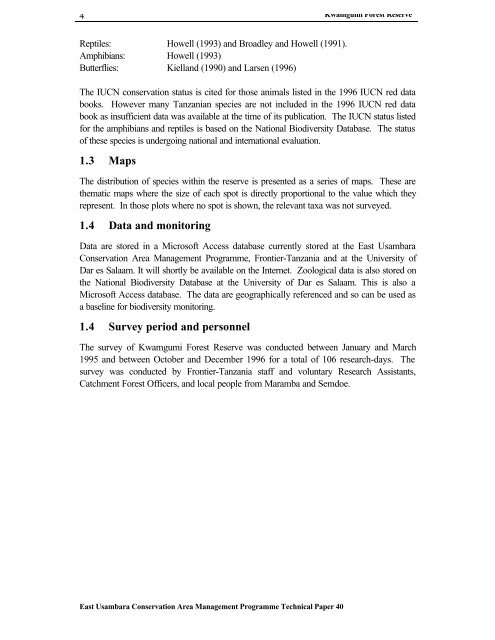Kwamgumi Forest Reserve - Frontier-publications.co.uk
Kwamgumi Forest Reserve - Frontier-publications.co.uk
Kwamgumi Forest Reserve - Frontier-publications.co.uk
You also want an ePaper? Increase the reach of your titles
YUMPU automatically turns print PDFs into web optimized ePapers that Google loves.
4 <strong>Kwamgumi</strong> <strong>Forest</strong> <strong>Reserve</strong><br />
Reptiles: Howell (1993) and Broadley and Howell (1991).<br />
Amphibians: Howell (1993)<br />
Butterflies: Kielland (1990) and Larsen (1996)<br />
The IUCN <strong>co</strong>nservation status is cited for those animals listed in the 1996 IUCN red data<br />
books. However many Tanzanian species are not included in the 1996 IUCN red data<br />
book as insufficient data was available at the time of its publication. The IUCN status listed<br />
for the amphibians and reptiles is based on the National Biodiversity Database. The status<br />
of these species is undergoing national and international evaluation.<br />
1.3 Maps<br />
The distribution of species within the reserve is presented as a series of maps. These are<br />
thematic maps where the size of each spot is directly proportional to the value which they<br />
represent. In those plots where no spot is shown, the relevant taxa was not surveyed.<br />
1.4 Data and monitoring<br />
Data are stored in a Microsoft Access database currently stored at the East Usambara<br />
Conservation Area Management Programme, <strong>Frontier</strong>-Tanzania and at the University of<br />
Dar es Salaam. It will shortly be available on the Internet. Zoological data is also stored on<br />
the National Biodiversity Database at the University of Dar es Salaam. This is also a<br />
Microsoft Access database. The data are geographically referenced and so can be used as<br />
a baseline for biodiversity monitoring.<br />
1.4 Survey period and personnel<br />
The survey of <strong>Kwamgumi</strong> <strong>Forest</strong> <strong>Reserve</strong> was <strong>co</strong>nducted between January and March<br />
1995 and between October and December 1996 for a total of 106 research-days. The<br />
survey was <strong>co</strong>nducted by <strong>Frontier</strong>-Tanzania staff and voluntary Research Assistants,<br />
Catchment <strong>Forest</strong> Officers, and local people from Maramba and Semdoe.<br />
East Usambara Conservation Area Management Programme Technical Paper 40

















